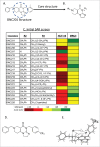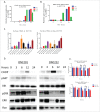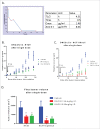Preclinical evaluation of the imipridone family, analogs of clinical stage anti-cancer small molecule ONC201, reveals potent anti-cancer effects of ONC212
- PMID: 28489985
- PMCID: PMC5628644
- DOI: 10.1080/15384101.2017.1325046
Preclinical evaluation of the imipridone family, analogs of clinical stage anti-cancer small molecule ONC201, reveals potent anti-cancer effects of ONC212
Abstract
Anti-cancer small molecule ONC201 upregulates the integrated stress response (ISR) and acts as a dual inactivator of Akt/ERK, leading to TRAIL gene activation. ONC201 is under investigation in multiple clinical trials to treat patients with cancer. Given the unique imipridone core chemical structure of ONC201, we synthesized a series of analogs to identify additional compounds with distinct therapeutic properties. Several imipridones with a broad range of in vitro potencies were identified in an exploration of chemical derivatives. Based on in vitro potency in human cancer cell lines and lack of toxicity to normal human fibroblasts, imipridones ONC206 and ONC212 were prioritized for further study. Both analogs inhibited colony formation, and induced apoptosis and downstream signaling that involves the integrated stress response and Akt/ERK, similar to ONC201. Compared to ONC201, ONC206 demonstrated improved inhibition of cell migration while ONC212 exhibited rapid kinetics of activity. ONC212 was further tested in >1000 human cancer cell lines in vitro and evaluated for safety and anti-tumor efficacy in vivo. ONC212 exhibited broad-spectrum efficacy at nanomolar concentrations across solid tumors and hematological malignancies. Skin cancer emerged as a tumor type with improved efficacy relative to ONC201. Orally administered ONC212 displayed potent anti-tumor effects in vivo, a broad therapeutic window and a favorable PK profile. ONC212 was efficacious in vivo in BRAF V600E melanoma models that are less sensitive to ONC201. Based on these findings, ONC212 warrants further development as a drug candidate. It is clear that therapeutic utility extends beyond ONC201 to include additional imipridones.
Keywords: ATF4; CHOP; DR5; ONC201; ONC206; ONC212; TRAIL; cancer therapy; imipridone.
Figures







Comment in
-
Imipridone family on successful TRAIL.Cell Cycle. 2017 Aug 18;16(16):1487-1488. doi: 10.1080/15384101.2017.1345237. Epub 2017 Jun 26. Cell Cycle. 2017. PMID: 28650792 Free PMC article. No abstract available.
-
Identification of more potent imipridones, a new class of anti-cancer agents.Cell Cycle. 2017;16(17):1566-1567. doi: 10.1080/15384101.2017.1355171. Epub 2017 Jul 27. Cell Cycle. 2017. PMID: 28749246 Free PMC article. No abstract available.
Similar articles
-
Dopamine pre-treatment impairs the anti-cancer effect of integrated stress response- and TRAIL pathway-inducing ONC201, ONC206 and ONC212 imipridones in pancreatic, colorectal cancer but not DMG cells.Am J Cancer Res. 2024 May 15;14(5):2453-2464. doi: 10.62347/ZOTV8006. eCollection 2024. Am J Cancer Res. 2024. PMID: 38859853 Free PMC article.
-
Potent preclinical sensitivity to imipridone-based combination therapies in oncohistone H3K27M-mutant diffuse intrinsic pontine glioma is associated with induction of the integrated stress response, TRAIL death receptor DR5, reduced ClpX and apoptosis.Am J Cancer Res. 2021 Sep 15;11(9):4607-4623. eCollection 2021. Am J Cancer Res. 2021. PMID: 34659909 Free PMC article.
-
Discovery and clinical introduction of first-in-class imipridone ONC201.Oncotarget. 2016 Nov 8;7(45):74380-74392. doi: 10.18632/oncotarget.11814. Oncotarget. 2016. PMID: 27602582 Free PMC article. Review.
-
ONC201 and imipridones: Anti-cancer compounds with clinical efficacy.Neoplasia. 2020 Dec;22(12):725-744. doi: 10.1016/j.neo.2020.09.005. Epub 2020 Oct 23. Neoplasia. 2020. PMID: 33142238 Free PMC article. Review.
-
Small-Molecule ONC201/TIC10 Targets Chemotherapy-Resistant Colorectal Cancer Stem-like Cells in an Akt/Foxo3a/TRAIL-Dependent Manner.Cancer Res. 2015 Apr 1;75(7):1423-32. doi: 10.1158/0008-5472.CAN-13-3451. Epub 2015 Feb 20. Cancer Res. 2015. PMID: 25712124 Free PMC article.
Cited by
-
Targeting Dopamine Receptor D2 by Imipridone Suppresses Uterine Serous Cancer Malignant Phenotype.Cancers (Basel). 2020 Aug 27;12(9):2436. doi: 10.3390/cancers12092436. Cancers (Basel). 2020. PMID: 32867127 Free PMC article.
-
ONC206 has anti-tumorigenic effects in human ovarian cancer cells and in a transgenic mouse model of high-grade serous ovarian cancer.Am J Cancer Res. 2022 Feb 15;12(2):521-536. eCollection 2022. Am J Cancer Res. 2022. PMID: 35261784 Free PMC article.
-
Anti-Tumor and Anti-Invasive Effects of ONC201 on Ovarian Cancer Cells and a Transgenic Mouse Model of Serous Ovarian Cancer.Front Oncol. 2022 Mar 17;12:789450. doi: 10.3389/fonc.2022.789450. eCollection 2022. Front Oncol. 2022. PMID: 35372029 Free PMC article.
-
Imipridones affect tumor bioenergetics and promote cell lineage differentiation in diffuse midline gliomas.Neuro Oncol. 2022 Sep 1;24(9):1438-1451. doi: 10.1093/neuonc/noac041. Neuro Oncol. 2022. PMID: 35157764 Free PMC article.
-
Highly potent dopamine receptor D2 antagonist ONC206 demonstrates anti-tumorigenic activity in endometrial cancer.Am J Cancer Res. 2021 Nov 15;11(11):5374-5387. eCollection 2021. Am J Cancer Res. 2021. PMID: 34873466 Free PMC article.
References
-
- Ishizawa J, Kojima K, Chachad D, Ruvolo P, Ruvolo V, Jacamo RO, Borthakur G, Mu H, Zeng Z, Tabe Y, et al.. ATF4 induction through an atypical integrated stress response to ONC201 triggers p53-independent apoptosis in hematological malignancies. Sci Signal 2016; 9(415):ra17; PMID:26884599; https://doi.org/10.1126/scisignal.aac4380 - DOI - PMC - PubMed
-
- Kline CL, Van den Heuvel AP, Allen JE, Prabhu VV, Dicker DT, El-Deiry WS. ONC201 kills solid tumor cells by triggering an integrated stress response dependent on ATF4 activation by specific eIF2α kinases. Sci Signal 2016; 9(415):ra18; PMID:26884600; https://doi.org/10.1126/scisignal.aac4374 - DOI - PMC - PubMed
-
- Allen JE, Krigsfeld G, Mayes PA, Patel L, Dicker DT, Patel AS, Dolloff NG, Messaris E, Scata KA, Wang W, et al.. Dual inactivation of Akt and ERK by TIC10 signals Foxo3a nuclear translocation, TRAIL gene induction, and potent antitumor effects. Sci Transl Med 2013; 5(171):171ra17; PMID:23390247; https://doi.org/10.1126/scitranslmed.3004828 - DOI - PMC - PubMed
-
- Ashkenazi A. Targeting the extrinsic apoptosis pathway in cancer. Cytokine Growth Factor Rev 2008; 19(3-4):325-31; PMID:18495520; https://doi.org/10.1016/j.cytogfr.2008.04.001 - DOI - PubMed
-
- Pan G, et al.. The receptor for the cytotoxic ligand TRAIL. Science 1997; 276(5309):111-3; PMID:9082980; https://doi.org/10.1126/science.276.5309.111 - DOI - PubMed
MeSH terms
Substances
LinkOut - more resources
Full Text Sources
Other Literature Sources
Medical
Research Materials
Miscellaneous
